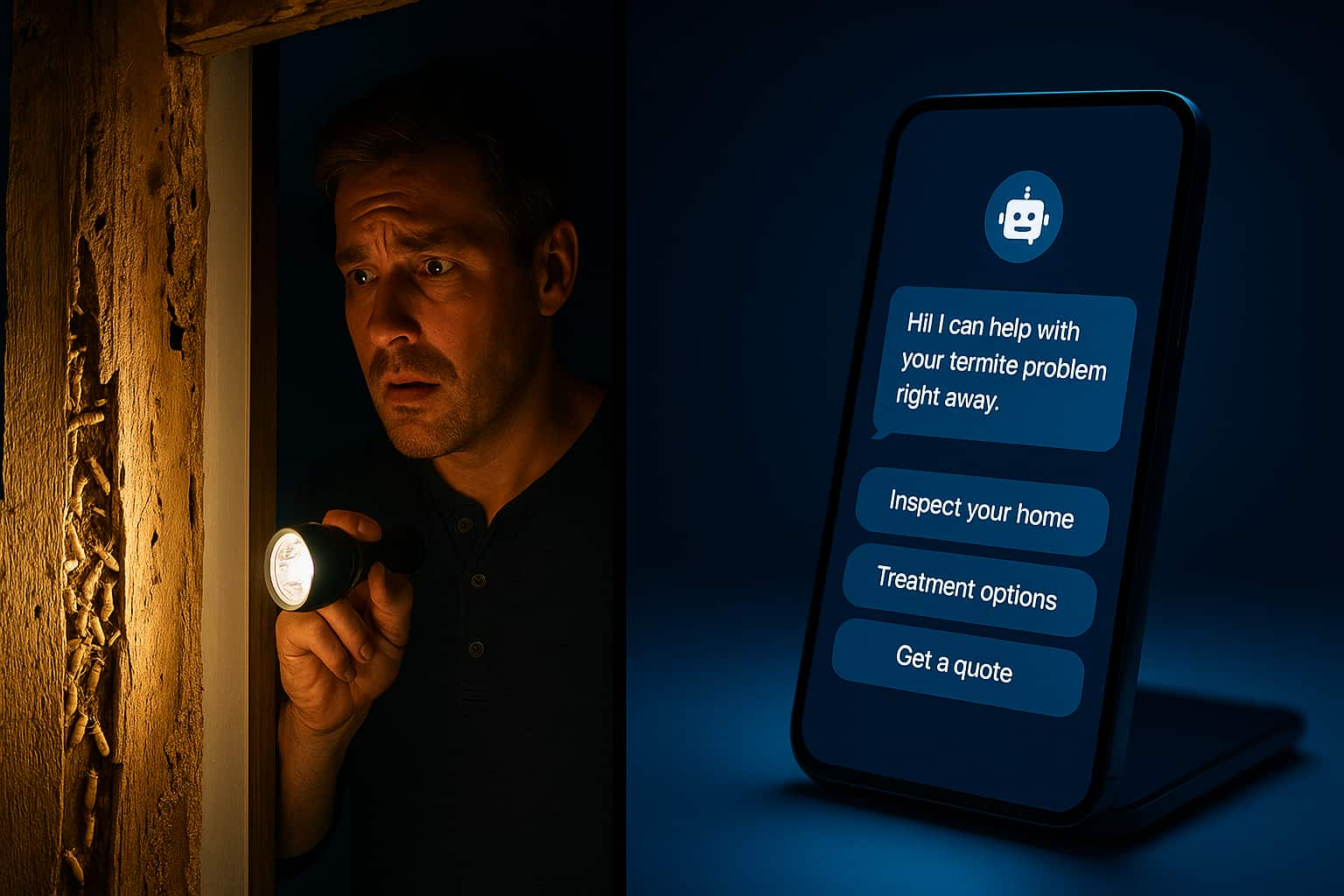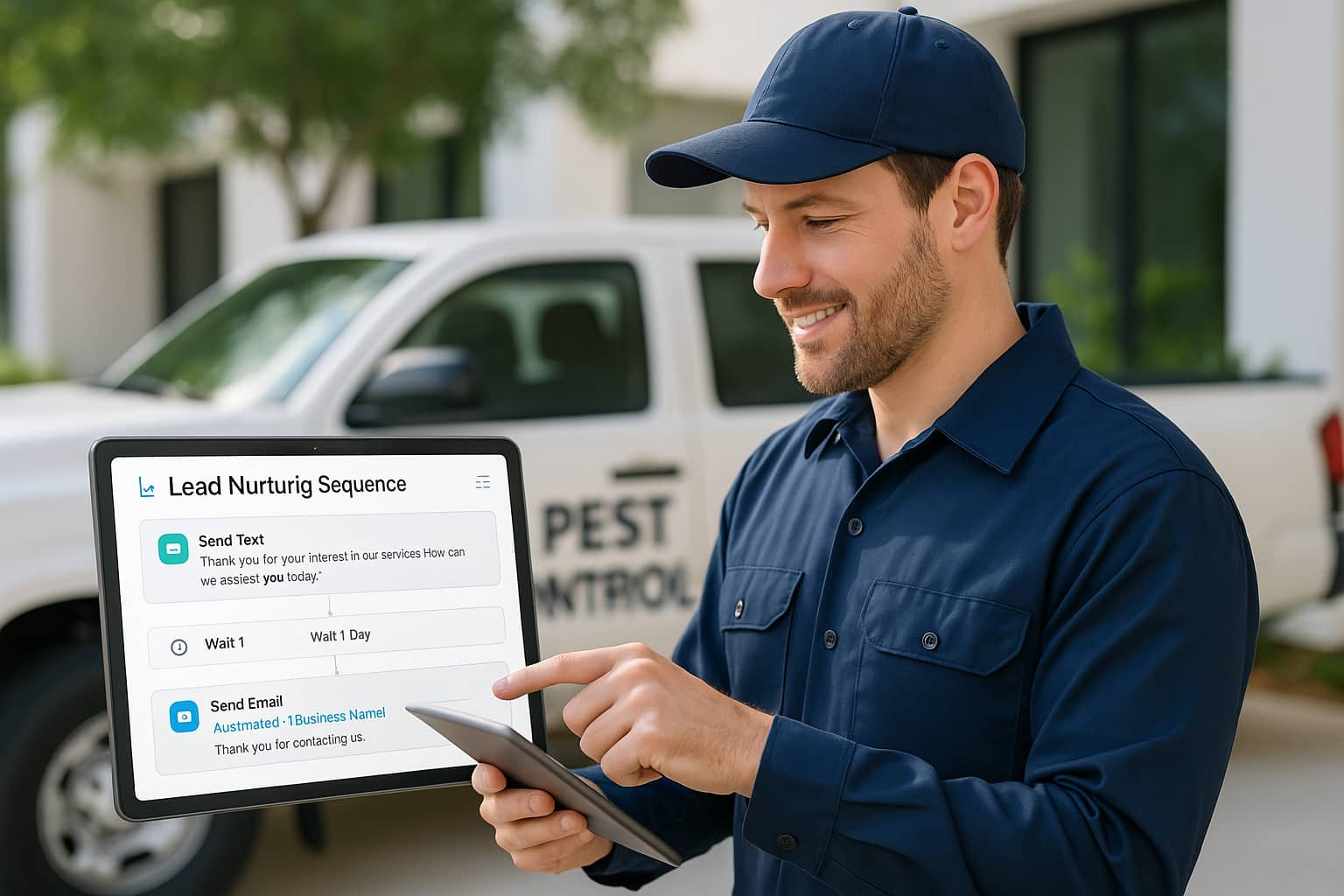How to Get More Pest Control Calls with an AI Chatbot
Picture this: It's 11 PM on a Saturday night. A homeowner discovers termites eating their deck. They're panicked and need help now. But your pest control company is closed until Monday morning.
That homeowner won't wait. They'll call the first company that answers. And if that's not you, you just lost a potential customer worth hundreds or thousands of dollars.
This happens every single day in the pest control business. According to Convin.ai, customers find pest problems at all hours, but most companies can't answer calls 24/7. This challenge affects all home services businesses. The result? Missed pest control leads, lost revenue, and frustrated potential customers.
AI chatbots solve this problem. They work around the clock to capture leads, qualify customers, and book appointments. Plus, they cost way less than hiring staff to work nights and weekends. This digital marketing solution helps with generating leads 24/7.
Here's everything you need to know about using AI chatbots to grow your pest control business with effective pest control marketing strategies.
Table of Contents
Why After-Hours Leads Matter So Much
How AI Chatbots Help Pest Control Marketing
Setting Up Your Pest Control Chatbot
Important Things to Consider
Real Results from Pest Control Companies
Your Next Steps
Why After-Hours Pest Control Leads Matter So Much
Pest control is an emergency business. When people find bugs, rodents, or termites, they want help right away. This urgency makes pest control lead generation different from other marketing for pest control companies. Waiting isn't an option.
Speed Wins Sales Every Time
The numbers don't lie. Speed gets you more customers, according to Voiso and LeadAngel:
78% of customers buy from the first company that responds
Responding in 5 minutes gets you 21 times more qualified leads than waiting 30 minutes
Wait just 10 minutes and you're 10 times more likely to lose the lead
First-minute responses boost conversions by 391%
Think about it. Your customer found termites at midnight. They're stressed and want answers now. If you don't respond until Monday morning, they've already hired someone else.
The Real Cost of Slow Response
Here's what happens when you're slow to respond:
Missing Emergency Calls: Pest problems feel like emergencies to customers. A family with bed bugs or a restaurant with roaches can't wait for business hours. These high quality leads need immediate attention.
Losing to Competitors: Other pest control companies answer faster. They get the business while you're sleeping. Smart pest control advertising includes 24/7 availability.
Frustrated Customers: Even if you eventually respond, customers remember waiting. Bad first impressions hurt your reputation.
Lost Revenue: Every missed lead costs you money. A single termite job can be worth $2,000-$5,000. Miss 10 leads per month, and you're losing serious money. This impacts your entire services business.
Why Manual Solutions Don't Work
Some companies try to handle after-hours calls manually. Here's why that fails:
Too Expensive: Paying staff to work nights and weekends costs a fortune. Most small pest control companies can't afford it.
Inconsistent Service: Different people handle calls differently. Your Saturday night person might not qualify leads the same way your Monday morning team does.
Human Error: Tired staff make mistakes. They forget to ask important questions or enter wrong information in your system.
Still Too Slow: Even with staff, calls to voicemail still create delays. Customers want instant answers.
The solution? AI chatbots that never sleep, never make mistakes, and cost a fraction of human staff. This is one of the most effective pest control marketing ideas for growing your business.
How AI Chatbots Help Pest Control Marketing
AI chatbots are computer programs that talk to customers through your website. According to The Online Group, they use smart technology to understand what people say and respond like a human would. This internet marketing for pest control tool works in real time.
For pest control companies, chatbots do three main jobs:
Capture pest control leads 24/7
Ask qualifying questions
Schedule appointments or send hot leads to your team
What Makes AI Chatbots So Effective
Always Available: Your chatbot never takes a break. It's ready to help customers at 3 AM on Christmas morning.
Instant Response: Customers get answers immediately. No waiting, no voicemail, no "we'll call you back."
Smart Conversations: Modern chatbots understand natural language, as explained by Legitt AI. Customers can say "I have bugs in my kitchen" instead of filling out rigid forms.
Perfect Memory: Every conversation gets saved. Your chatbot remembers what customers said and passes that information to your team.
Consistent Quality: Your chatbot follows the same process every time. Every customer gets the same professional experience.
Key Features That Help Pest Control Companies
Pest-Specific Questions: Your chatbot can ask targeted questions based on the pest type. Termite problems need different information than ant problems.
Urgency Assessment: The chatbot figures out which leads need immediate attention. A customer with a wasp nest near their front door gets priority over someone with occasional ants.
Service Area Verification: No point qualifying leads outside your coverage area. The chatbot checks service area locations first.
Appointment Booking: Advanced chatbots connect to your scheduling system. According to Copilot.live, they can book inspections while the customer is online.
Lead Scoring: Based on the conversation, your chatbot assigns priority scores. As Emitrr explains, your team knows which leads to call first.
The Business Benefits Add Up Fast
Never Miss Another Lead: Every website visitor gets immediate attention, even at 2 AM. This beats traditional pest control ads that only work during business hours.
Higher Conversion Rates: Fast response times mean more leads become customers.
Lower Labor Costs: One chatbot replaces multiple staff members for basic lead qualification.
Better Data Quality: Automated data collection means fewer errors in your customer database.
Happier Customers: People love getting instant help. Great first impressions lead to positive reviews.
More Efficient Team: Your staff spends time on high-value activities instead of answering basic questions. This improves your overall marketing efforts.
Setting Up Your Pest Control SEO Chatbot
Getting your chatbot up and running takes planning, but the process is straightforward. Here's how to do it right for maximum pest control lead generation.
Step 1: Plan Your Strategy
Set Clear Goals: What do you want your chatbot to accomplish? According to GPTBots, common goals include:
Capture contact information for all after-hours visitors
Qualify leads based on pest type and urgency
Book inspection appointments automatically
Answer frequently asked questions
Reduce missed leads by 90%
These goals help you compete with other lead generation companies.
Choose Your Locations: Where will customers interact with your chatbot? Most companies start with:
Homepage of your website
Service pages (termite control, rodent removal, etc.)
Contact page
Pricing pages
This helps improve your search results visibility and pest control SEO.
Pick Your Platform: Look for chatbot platforms that offer:
Easy setup without coding knowledge
Good integration with your current systems
Pest control templates or customization options
Reliable customer support
Reasonable pricing
Popular options include Intercom, Tidio, Drift, and specialized pest control platforms like Ochatbot's Pest Control LeadBot. Many offer better results than traditional pay per call services.
Step 2: Design Your Conversations
Create Natural Conversation Flows: Map out how conversations should go, following best practices from Giosg. For example:
Chatbot: "Hi! I'm here to help with your pest control needs. What type of pest problem are you dealing with?"
Customer: "I think I have termites"
Chatbot: "I understand how concerning termites can be. To help you quickly, I need a few details. Where are you seeing signs of termites?"
Ask the Right Questions: Your chatbot needs specific information to qualify leads:
Contact details (name, phone, email, address)
Property type (home or business)
Pest identification
Location of the problem
How long the problem has existed
Severity level
Previous treatment attempts
Urgency level
Keep It Simple: Start with basic flows for your most common pests. You can add complexity later. Focus on marketing strategies that work first.
Step 3: Train Your Chatbot
Load Frequently Asked Questions: Give your chatbot answers to common questions like:
"How much does pest control cost?"
"Are your treatments safe for pets?"
"How quickly can you come out?"
"Do you guarantee your work?"
This information helps with lead generation services and customer education.
Add Pest Information: Include basic facts about common local pests. This helps your chatbot provide helpful information during conversations.
Set Up Company Details: Make sure your chatbot knows your service hours, coverage areas, and basic policies.
Step 4: Connect Your Systems
CRM Integration: This is crucial. Your chatbot must send lead information directly to your customer management system. Popular integrations include:
ServiceTitan
PestPac
FieldRoutes
Salesforce
HubSpot
Scheduling Software: If you want appointment booking, connect your chatbot to your scheduling system.
Phone System: Some chatbots can transfer calls to your team when needed.
Step 5: Set Up Escalation Rules
Define When to Transfer: According to AIGN, your chatbot should pass conversations to humans when:
The customer specifically asks for a person
The situation seems urgent or dangerous
The chatbot can't understand what the customer needs
Technical problems arise
Create Smooth Handoffs: When transferring to a human, PartnerHero recommends making sure:
The person gets the full conversation history
The customer doesn't have to repeat information
The right team member gets the lead (sales, service, etc.)
Step 6: Launch and Monitor
Start Small: Test your chatbot on one page first. Make sure everything works before expanding. This approach helps you avoid problems while growing your business.
Track Performance: Monitor key metrics like:
How many visitors start conversations
How many conversations end successfully
Lead quality and conversion rates
Customer satisfaction scores
Social media integration can also boost these numbers.
Improve Continuously: Use conversation logs to identify problems and make improvements. Your chatbot gets smarter over time.
Important Things to Consider
While chatbots offer huge benefits, you need to handle a few important areas carefully.
Protecting Customer Information
Pest control chatbots collect personal information like names, addresses, and phone numbers. According to SmythOS, you must protect this data properly.
Follow Privacy Laws: Depending on your location and customers, you might need to comply with regulations like:
California Consumer Privacy Act (CCPA)
General Data Protection Regulation (GDPR) for European customers
State privacy laws
Be Transparent: Tell customers they're talking to a chatbot, not a human. Explain what information you're collecting and why.
Get Permission: Ask customers if it's okay to collect their information before you start gathering details.
Keep Data Secure: Choose chatbot platforms with strong security features. Make sure customer data is encrypted and protected.
Keeping Customers Happy
Your chatbot represents your company. It needs to provide a great experience.
Match Your Brand: Your chatbot's tone should match your company personality. Professional but friendly usually works best for pest control.
Provide Easy Escapes: Always give customers a clear way to talk to a human if they prefer.
Set Realistic Expectations: Don't promise things your chatbot can't deliver. If it can't give instant quotes, say so upfront.
Handle Frustration Well: Some customers will get frustrated with chatbots. Train your bot to recognize this and transfer to humans quickly.
Planning for Challenges
Technical Problems: Chatbot platforms sometimes have issues. Have backup contact methods ready.
Language Limitations: AI isn't perfect. Your chatbot might misunderstand complex or unusual requests. Regular monitoring helps catch these issues.
Customer Resistance: Some people don't like chatbots. That's okay. Give them other ways to contact you.
Cost Management: Factor in platform fees, setup costs, and ongoing maintenance. As Chat360 notes, track your return on investment carefully.
The key is starting simple and improving over time. Your first chatbot doesn't need to be perfect. It just needs to capture leads better than your current system.
Real Results from Pest Control Companies
While chatbots are still new in pest control, early adopters are seeing great results. Here's what companies are achieving.
Pest Control Success Stories
Rentokil Initial: This global pest control company used digital marketing tools including chatbots as part of their strategy. According to HubSpot's case study, results included:
44% increase in website traffic
43% more customers
671% return on marketing investment
Pointe Pest Control: According to Dashly, by improving their lead capture and response systems, this company cut customer acquisition costs from $104 to just $10 per customer.
Steve's Pest Control: Using digital marketing and better lead management, they achieved 15-30% annual growth and 180% more conversions in new markets.
Moxie Pest Control: Implemented AI tools to improve customer service operations, with plans to add automated customer interactions for even better results.
What the Numbers Show
The broader business world is embracing AI chatbots because they work, according to Desk365:
High Adoption: 72% of businesses used AI in 2024, with small businesses increasingly using chatbots to compete.
Cost Savings: Companies save up to 30% on customer service costs with AI automation.
Faster Service: AI tools improve response times by up to 50% and resolution speed by 37%.
Customer Acceptance: Over 67% of consumers have used chatbots and are comfortable with them.
Why This Matters for Your Business
These results show a clear trend. Customers expect faster service, and AI helps companies deliver it. Pest control companies that adopt chatbots now gain advantages over slower competitors.
The companies seeing the biggest improvements share common traits:
They integrate chatbots with existing systems
They train chatbots specifically for their industry
They monitor performance and make improvements
They use chatbots as part of broader digital strategies
Your Next Steps
After-hours lead management is a real problem for pest control companies. You're losing customers and revenue every time someone can't reach you outside business hours.
AI chatbots solve this problem efficiently and affordably. They capture leads 24/7, qualify customers instantly, and cost far less than human staff.
The evidence is clear: faster response times dramatically improve conversion rates. Companies that respond first get the business 78% of the time. Those that respond within 5 minutes get 21 times more qualified leads.
Here's What to Do Now
Evaluate Your Current Situation: How many leads are you missing after hours? How long does it take you to follow up on web forms? The bigger these problems, the more a chatbot will help.
Start Simple: Pick one or two common pest problems to focus on first. Don't try to automate everything at once.
Choose the Right Platform: Look for chatbot software that integrates well with your current systems. This is crucial for success.
Design for Your Industry: Generic chatbot templates won't work well for pest control. Invest time in creating pest-specific conversation flows.
Plan Your Handoffs: Make sure you have clear processes for transferring conversations from chatbots to humans when needed.
Monitor and Improve: Track your results and keep making improvements. Your chatbot gets better over time.
Follow Privacy Rules: Protect customer data from day one. This builds trust and keeps you compliant with laws.
The pest control companies that implement chatbots first will gain significant advantages. Better lead capture, higher conversion rates, lower costs, and happier customers.
Don't let competitors capture the leads you're missing. The technology is ready, the customers expect it, and the benefits are proven.
ResultCalls specializes in helping pest control companies implement cutting-edge lead capture systems that dramatically improve response times and conversion rates.
If you want to get more pay per call pest control leads, sign up for free today!

Alex Gambashidze
Marketing Associate at ResultCallsHello everyone! My name is Alex and I write these blogs to help educate small business owners on different ways to grow their business. My goal is to make lead generation as easy as possible for you. After reading these blogs, I hope you leave with some actionable steps that will get you closer to growing your business :)
2,000+
Happy local businesses
See what some of them have to say.


